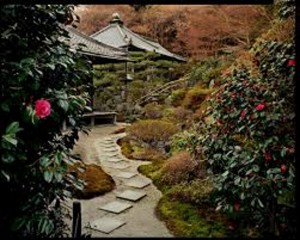
日本のガーデン
There is hardly another place in the world where the landscape art has been inspired as tenderly as it is in Japan. Even in early middle ages Japanese people paid special attention to the nature by creating wonderful gardens and parks. This is called landscape in European culture. These gardens were meaningful in Buddhist conceptions. The island was in the centre of the composition (rocks, pavilions) surrounded by lakes. It was considered to be the heaven symbol in the middle of the ocean. Famous Byodo-in temple located in Byodo-in Uji (nearby Kyoto) is a wonderful example. A little wooden building-Phoenix hall is in the middle of the lake. It keeps Buddhist amid statue.
In early times (in the 12the century) the theoretical sense of gardens and parks was developed. Accordingly, a lot of works appeared. In the period of Kamakura (1185-1333) Zen-Buddhism had certain importance. For Zen-Buddhism the nature study was one of the important means of lightening. The main principal of Japanese gardening was gradually formed. It was based on irregularities and imbalance.
Theoretically there are 2 main types of gardening:

«Tsukiyama»-is a creation of real, mountainous landscape with compulsory use of lakes, hills and rocks. Frequently Japanese and Chinese famous nature sightseeing were created (Fuji Mountain). Anyhow, every creation was also spiritual-symbolic in significance. Accordingly, their interaction came during walk through gardens. For instance, the upper garden of Sayhoji temple of Kyoto (created in 1339) is an old garden with its firm stones and rocks. It symbolizes the nature power.

«Hiraniva»- is not a big but plane garden from the fixed point describing the nature as miniature. Zenski gardens were the real manifestation and symbol of these kinds of gardens. Actually gardens were considered to be «dry landscape» gardens (karesansui). There were no waters there, at all. The sea and the river were described with sand, the mountains with rocks, the islands with moss and bushes. The conventionality of these gardens brought deep and long study (meditation). These gardens were the inseparable part of Zen monastery. More famous gardens are Ryoan-ji (XV century) and Daisen-in (1509-1513 Kyoto).

The tea gardens (tyaniva) are also considered to be special. They were famous in XV-XVI centuries with the tea production development. These gardens are not big; moreover, they are not gardens, at all. It is a path with a café surrounded with plants and stones. The scene helps to achieve loneliness. It gradually takes a person far away from secular illusions with Zen inspiration.
In Edo era (1603-1868) the gardens with huge landscape were worldwide. As in early times they were created with a lake around and the island in the centre. However, these gardens had similarities with gardens of different eras, for example, tea gardens or stone gardens. For instance, little garden of Katsura royal villa (1610-1650) was created not only for peaceful walking, but also for nature admiration. These scenes were naturally described on the windows of various pavilions. The other royal and luxurious garden with artificial form, however, principle is to make the landscape as real and natural as possible. The lake is on the pick of massive mountains surrounded with islands and bridges. It has theatrical background which is obvious from various corners of the garden. Accordingly, it becomes a part of the garden space. Such kinds of gardens were created not only for royals but for feudal nobles, too. The three of them are the most beautiful gardens of Japan, for example, Kenrokuen (1676) in Kanazawa (Ishikawa prefecture), Korakuen (1687) in Okayama (Okayama prefecture) and Kairakuen (1841) in Mito city (Ibaraki prefecture).
Japanese gardens and parks are beautiful in all seasons of the year. They are wonderful under the rain veil, in the mist of fog, in snowy winter and in beautiful crimson fall. However, they are beautiful in early spring, in the period of cherries blossoming.
http://visitjapan.ru/japan/sady/から取られた材料










